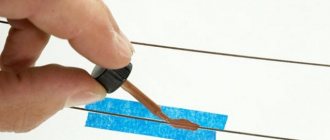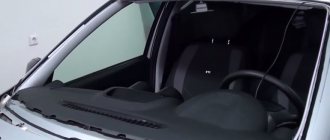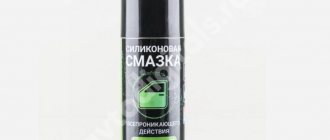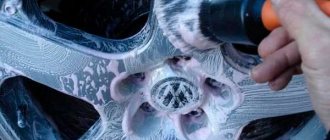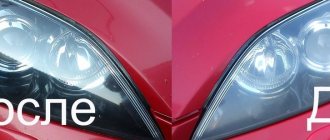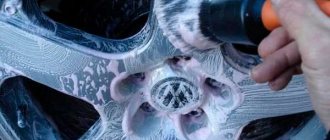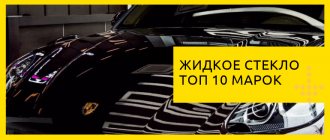Glass polish allows you to improve its appearance by increasing transparency by removing small scratches, and increasing the quality of visibility. There are several types of car glass polishes - universal, abrasive, protective. Many of them have dirt- and moisture-repellent properties. Therefore, choosing a polish for car glass is always a compromise decision.
And to find out for yourself which glass polishing agent will be best, first decide what purpose you want to achieve. This could be: cleaning glass, removing scratches, or protecting against rain and dirt.
| Polish name | Brief description and characteristics | Package volume, ml/mg | Price of one package as of winter 2019/2020, Russian rubles |
| Doctor Wax Glass Polisher-Stripper | Very effective polishing and cleaning agent. Removes turbidity from glass and polishes scratches perfectly. The main advantage is low price with excellent performance characteristics. | 300 | 400 |
| Glass Gloss | There are two types of glass polishing pastes available - basic and finishing. Mainly used in detailing companies. It polishes glass perfectly, but a significant drawback is the high price. | 250 | 3000 |
| Grass nano-protection NF04 | It is more of a protective agent. Creates a protective film on the glass surface, including scratches and abrasions. It has an anti-rain effect, protects glass from water, dirt, and insects. Has a long-term effect. Can be used at home. | 250 | 600 |
| Sonax ProfiLine Glass Polish | A universal product for cleaning and polishing the surface of the windshield. Used with a grinder. It polishes small scratches well, but does not cope with deep damage. | 250 | 1300 |
| Hi Gear | Positioned as a polish, but is often used as an anti-rain. It sands small scratches well during processing, but it cannot handle old and deep abrasions. It is better to use it as a preventive and protective agent against dirt. | 236 ml; 473 ml | 550 rub; 800 rub. |
| Turtle Wax ClearVue Glass Polish | Cleaning and polishing agent. You can process not only glass, but also plastic, including headlights. It has a creamy structure on a non-abrasive basis. It removes small scratches, but not deep ones. | 500 | 430 |
| Willson | Glass polish and cleaner with diamond chips with polish elements. Designed for manual processing, the kit includes a hand sponge. Shows good efficiency, but has a high price for a small packaging volume. In addition, it is rarely found on sale. | 200 ml; 125 ml. | 1000 rub; 1000 rub. |
What types of polishes are there for car glass?
Manufacturers of polishes give their products not only the ability to directly polish a glass surface, but also perform other functions. Therefore, the mentioned funds are divided into the following types:
- Universal . This is the most common and numerous type of polish. Such products can effectively clean and directly polish damaged glass surfaces. The composition includes both abrasive and cleaning elements. but as practice shows, the more universal, the less effective it is. Such car windshield polishes can be used as a preventive measure.
- Abrasive . Such products do not contain cleaning components. Often, abrasive polishes are used to remove spider-like damage. They can be successfully used for polishing windshield or other car windows. They are often used to remove old abrasions from working windshield wipers.
- Protective . Such anti-scratch polishes are often used as preventative agents. In particular, they form a thin film on the glass surface that has water and dirt-repellent properties. Thanks to this, the treated glass remains clean for a long time, even if the car is used in the rain and/or off-road. Protective polishes are also used to prevent the wiper blades from freezing to the glass.
All of the above products are wax or Teflon based. Wax polishes are older and less effective. However, they have an undeniable advantage - a lower price. Conversely, Teflon polishes are a newer and more technologically advanced development that are highly effective in both polishing and protecting glass. The only disadvantage we can highlight is the higher price compared to their wax counterparts.
Types of scratches and causes of their occurrence
The shield is daily exposed to grains of sand and small particles, which leave clouding and micro-scratches. The appearance of defects is influenced by:
- old cleaner brushes that have lost their softness;
- scrapers for cleaning the surface from ice;
- poor quality car washing with a contaminated sponge;
- vandalism.
The cleaner has a strong influence on the appearance of abrasions. Novice motorists forget about the operation of the system due to increased attention to the driving process, and the rubber band moves along the surface after the rain stops. This applies to the rear shield on crossovers, station wagons and hatchbacks equipped with a glass cleaning system. Shallow, small scratches eventually form a whitish veil along the contour of the cleaner.
Ice scrapers and washing with dirty tools lead to damage to both the side and windshield glass. In this case, the sand grains scratch the surface and leave deeper marks.
Intentional damage to property by vandals leads to irreversible consequences. If the outer part is damaged by sharp objects, and the scratch is felt with a fingernail, then such a defect cannot be eliminated by polishing.
What to look for when choosing
In addition to the type of car glass cleaner/polish itself, when choosing, you also need to take into account several more parameters. In particular:
- State of aggregation . As a rule, polishes for glass protection are sold in the form of a paste or gel. However, their viscosity and density may vary. Thicker compounds are suitable for repairing significant (deep) abrasions and are usually sufficient for a relatively small area to be treated. Conversely, thinner compounds are designed to treat minor abrasions.
- Terms of Use . Most car glass polishing pastes can be used simply in a garage, without the use of additional tools. However, there are also professional compositions that only work in conjunction with additional equipment. They are usually used in car service settings.
- Grain . The coarser the polish is, the deeper scratches it is designed to handle. Conversely, fine-grained compounds are capable of treating minor damage (fine finishing).
- Additional properties . It is desirable that the polish not only directly polishes the glass surface, but also protects the car glass from moisture, dirt and minor mechanical damage. This will provide better visibility through the glass and improve its appearance.
- Value for money . It is better not to buy frankly cheap products for polishing car glass, since they are not only ineffective, but, on the contrary, can damage its surface. It is better to purchase a polish from the middle or higher price category.
Process description
How to polish glass? This simple procedure requires effort and care.
Apply the abrasive composition to the felt circle and to the glass (pointwise). Once the mixture has soaked into the felt, you can polish the glass. The polishing tool is set to low speed, and the movements should be smooth, straight and continuous. In this case, it is necessary to monitor the operation of the circle - its braking indicates that the paste is beginning to dry out, so the car glass being treated should be moistened with water.
To evaluate the result, it is recommended to periodically remove the paste with a napkin or paper towel. The effectiveness of the work performed can be assessed not only from the outside, but also from inside the salon. If deficiencies are identified, the entire process can be repeated.
Read also: How to switch from gel polish to polish?
Rating of the best glass polishes
The list of the best car glass polishes includes only some of the most popular and effective anti-scratch glass products. The rating was compiled based on reviews found on the Internet and real application tests.
Doctor Wax
Doctor Wax Glass Polisher-Stripper effectively cleans cracks and chips and polishes the surface. Can be used to remove remnants of old polishes, traces of atmospheric precipitation, particles of tar, insects, silicone, as well as direct abrasions on glass. Made on an abrasive basis. Designed for use in conjunction with a grinding machine. However, when working, you need to use a soft polishing wheel so as not to damage the glass!
Positive reviews indicate that Doctor Wax Glass Polisher-Stripper is one of the best products in its segment. Some car enthusiasts even use this product to polish individual damaged areas on the paintwork of a car body. After using Doctor Wax glass polish, it is advisable to apply a water-repellent protective composition. An additional advantage is its ubiquity on sale, as well as its affordable price.
Sold in a small plastic canister with a volume of 300 ml. The packaging item for purchase in the online store is DW5673. The price of one such package as of winter 2019/2020 is about 400 rubles.
1
Glass Gloss
Under the brand name Glass Gloss LP 1976, two types of polishing pastes for automobile glass are produced - basic polishing and finishing polishing. It is used both in garage conditions and by detailing companies. The difference between the main paste and other analogues with cerium oxide is the fact that its base is made of three different types of abrasive particles of different fractions and different materials. This provides a single, versatile and effective abrasive base. Finishing paste is designed to remove even the smallest abrasions and scratches.
It is positioned more as a professional product, since it is intended to be used with high-quality polishing machines and discs. Reviews note the high efficiency of the product. The only disadvantage we can note is the very high price for a small packaging volume.
Thus, the main and finishing polishing pastes are sold in packages of the same volume, 250 ml in size. The instructions indicate that one such package is enough to process ten windshields, but experienced craftsmen manage to “stretch” it up to 15...18 cars.
The price of the kit as of the above period is about 3,000 Russian rubles.
2
Grass
Grass nano-protection polish NF 04 is a fairly popular product among car enthusiasts who have polished glass themselves at least once. The product has more of a protective property than a polishing one. Thus, its mechanism of action is the formation of a thin protective film on the glass surface, including in places of depressions (scratches, abrasions). All this leads to the restoration of normal visibility through the glass, and also restores its smoothness, glare and distortion disappear. Designed for use with a sander.
Using the Grass Nano Force glass protection coating, you can treat not only car windshields, but also headlights, side and rear windows, motorcycle helmet glasses, and household glass. Thanks to the film formed by the polish, the glass gets an anti-rain effect, that is, while driving at speed in the rain, the oncoming air flow blows the water down and to the sides. Which in turn increases the service life of rubber wiper blades.
Reviews about nanocoating for Grass glass are mostly positive. The only downside is the small amount of packaging. Thus, the product is sold in a 250 ml bottle with a manual trigger sprayer. The price of one package is about 600 rubles.
3
Sonax
Sonax ProfiLine Glass Polish is positioned by the manufacturer as a universal product based on non-abrasive materials. Designed to remove abrasions and stains on the surface of windshields and other glass, as well as headlights. Effectively removes stains from glass surfaces. It can be used for both manual and automatic (using a grinder) polishing, but the latter option is preferable.
Car owners who have used Sonax ProfiLine Glass Polish speak positively about its effectiveness in polishing minor scratches and abrasions. However, you need to work with a microfiber wheel and a sanding machine. It is practically not suitable for manual processing. It is also noted that the polish is not able to remove significant damage to glass. Among the disadvantages, it is worth noting its relatively high price compared to competitors with average performance characteristics.
Sonax glass polish is sold in a small 250 ml plastic bottle. The article number by which you can buy the polish in the online store is 273141. The approximate price of one bottle is 1,300 rubles.
4
Hi Gear
Hi Gear Rain Guard is positioned as a glass protection polish, but in practice it is more used as an anti-rain. In particular, it is a protective agent that forms a thin film on the surface of the glass, which both fills small scratches and provides protective properties. High Gear polish is recommended for use on windshields, rear windows, and side windows. It can be used to treat side rear view mirrors and headlights.
The results of using the polish in practice show that the product is able to eliminate only small and minor abrasions; accordingly, it is not able to cope with significant scratches, including old ones. Hi Gear Rain Guard glass polish is preferable to use as a preventative agent to protect the glass surface from moisture and dirt. Another disadvantage is the relatively high price.
Sold in two types of packaging. The first is a 236 ml bottle, in which the product is in transparent liquid form. The article number of this package is HG5644, its price is 550 rubles. The second type of packaging is a bottle with a manual sprayer (trigger) with a volume of 473 ml. The product code is HG5649, and the price is 800 rubles.
5
Turtle Wax
Turtle Wax Clear Vue Glass Polish 53004 is a creamy cleaner with a polishing effect. Made on a non-abrasive basis. It can not only effectively remove old and stubborn dirt from it, such as tar, downed insects, poplar fluff or tree sap, but also polish glass and plastic surfaces. Glass Polish Clear Vue effectively polishes out minor scratches.
This polish can be used for glass, plastic and surface treatment of car headlights. Can also be used at home, for example, for cleaning plastic window frames or balconies.
Tests and reviews indicate the non-average effectiveness of Turtle Wax glass polish. It allows you to remove only minor scratches, but it is not able to cope with serious damage. When processing the surface, it is advisable to use a grinding machine and a soft grinding wheel. Turtle Wax Clear Vue Glass Polish FG6537 is sold in a 500 ml Hg bottle with a manual trigger sprayer. TC60R. The price of one such package is about 430 rubles.
6
Willson
The Japanese manufacturer Willson WS-02042 produces two similar compositions - Willson glass polish, as well as Willson glass cleaner with diamond chips and a sponge. The first composition is intended for direct polishing of the surface of windshield, rear or side windows. The second is used for cleaning and polishing small scratches and marks on the glass surface. Polishes are intended for manual use only. So, the kit comes with a bottle of liquid product, as well as a sponge for manual processing. Apply the product to pre-washed glass!
The effectiveness of polishes can be defined as average. Car enthusiasts who have used Wilson polishes note that often one treatment is not enough, and that to achieve an acceptable effect, the glass must be treated with polish two or more times. And taking into account the high price of the product, it received one of the last places in the presented rating. In addition, Wilson glass polish is often difficult to find on sale, only in official representative stores.
Willson glass polish packaging has a volume of 200 ml. The price of the package is about 1000 rubles. The packaging of the cleaner-polish with diamond chips has a volume of 125 ml. Its price is similar.
7
If you have had your own experience using this or that polish, share it in the comments.
Scratches on the windshield, how they appear
Even the most durable metal parts are subject to the aging effect, let alone car windows. Moreover, it is the windshield that, while the car is moving, encounters the air rushing towards it, which contains dust, small and large grains of sand, all these impurities act as an abrasive element.
Particles of dust and sand falling under the wiper blades also cause scratches along the entire trajectory of their movement. The car owner himself can cause a lot of damage to the surface: when wiping dusty glass with a dry cloth, microscopic scratches occur and the surface becomes dull.
It is impossible to ignore the changes taking place. Scratches are far from a cosmetic defect that affects the aesthetic appearance of the car.
Problems are caused by pebbles falling into the windshield and flying out from under the wheels of other cars. In such cases, there is an option for scratches and chips to form; it is problematic to eliminate them on your own.
DIY glass polish
If for some reason the car owner cannot or does not want to buy a special glass polish, then such a product can be replaced with an analogue or made with your own hands.
Paste GOI
To prepare a composition that can cope with polishing car glass you will need:
- GOI paste (State Optical Institute). The number of the paste (1, 2, 3 or 4) depends on the depth of the scratch; accordingly, the lower the number, the more fine the paste is intended for finishing (it has a fine grain). Quantity - 30...40 grams.
- Sunflower oil.
- Candle or other open flame source.
- Metal jar.
- Water, cloth, hairdryer.
The preparation and processing algorithm is as follows:
- Grind the indicated 30...40 grams of GOI paste using a fine grater. Place the resulting powder in a metal jar.
- Add sunflower oil to the same jar. The amount of oil should be just enough to cover the level of the paste.
- Heat the mixture over a candle or burner.
- Stir the paste until you get a homogeneous mass. The process usually takes 2...3 minutes.
- Rinse the glass with water and dry with a hairdryer. Then, using soft felt, you can begin the polishing process with the resulting mixture.
It is indicated that the effect of using this composition is quite good. However, sometimes the treated area will shine in the sun . After this treatment, some car enthusiasts apply a fine abrasive polishing paste to the damaged area.
Cerium oxide
Very often, garage auto repairmen use cerium (IV) oxide to remove scratches on glass; other names are cerium dioxide, cerium dioxide (English name: Cerium Oxide). However, it has many subtleties of use, otherwise you can ruin the glass completely!
The product is a pale yellow, pink or white refractory powder. It is used in industry and in domestic conditions, including for polishing glass, ceramics, and cutting stones.
When purchasing this anti-scratch glass polish, it is important to pay attention to the content of the main substance, as well as the fraction size. Accordingly, the finer the fraction, the finer processing it is intended for. One of the optimal options would be 70% substance content and a fraction size of 0.8 microns. As for the proportions for mixing with water, it depends on the depth and size of the scratches being treated. So, the deeper the damage, the thicker the solution should be. In general, the consistency should be creamy.
For polishing, it is also important to choose a polishing wheel. For surface polishing, a foam pad or sheepskin pad is suitable. For deeper processing, it is better to use a felt circle. The selected wheel must be put on a drill with adjustable speed or use a grinding machine.
Also for work you will need clean rags and a spray bottle with water in order to periodically wet the glass and prevent it from overheating. Before processing, the glass must be thoroughly washed. It is advisable to mark the damage areas on the back of the glass with a marker. During work, you need to ensure that the glass does not overheat, and control your efforts and not put too much pressure on the surface!
Interestingly, cerium oxide itself, although it transmits light, strongly absorbs ultraviolet radiation, which can be useful when using a car with polished glass in bright sunny weather. This will be an additional argument that polishing the windshield still makes sense.
Toothpaste
Toothpaste can also be used as a polish. However, only one that has a whitening effect. Apply a small amount of paste to a cotton swab and rub the paste in a circular motion into the damaged area on the windshield. After this, the glass needs to be rinsed thoroughly. In most cases, the effectiveness of this treatment is very weak, unlike when used on plastic headlights, but if the abrasions on the glass are minor, it will also work.
A product capable of masking large scratches, rather than removing them by polishing, can be found not only in the bathroom, but also in a woman’s cosmetic bag.
Manicure polish
colorless manicure varnish is suitable for treating the windshield . It is carefully applied (usually with a needle) to the scratch, after which time is allowed to dry. You need to work carefully so that the varnish gets only to the damaged area! Using varnish you can treat fairly deep abrasions. Excess pieces of varnish can be removed using a stationery eraser or rubber spatula.
The disadvantage of this method is that when light hits the treated area of glass, the angle of refraction of the glass and the dried varnish will be different, so problems with visibility may arise.
Scratches on the windshield, how they appear
Even the most durable metal parts are subject to the aging effect, let alone car windows. Moreover, it is the windshield that, while the car is moving, encounters the air rushing towards it, which contains dust, small and large grains of sand, all these impurities act as an abrasive element.
Particles of dust and sand falling under the wiper blades also cause scratches along the entire trajectory of their movement. The car owner himself can cause a lot of damage to the surface: when wiping dusty glass with a dry cloth, microscopic scratches occur and the surface becomes dull.
It is impossible to ignore the changes taking place. Scratches are far from a cosmetic defect that affects the aesthetic appearance of the car.
Problems are caused by pebbles falling into the windshield and flying out from under the wheels of other cars. In such cases, there is an option for scratches and chips to form; it is problematic to eliminate them on your own.
Determining the extent of car damage
Before starting work, you will need to assess the severity of the defects, as this will determine the nuances in polishing.
- minor changes in the appearance of the glass surface are minor abrasions and scratches no more than 200 microns deep. Work to eliminate defects is carried out using a felt or fine abrasive wheel and fine-grained pastes containing manganese or zinc. The essence of polishing is to remove the thinnest layer from the glass;
- medium damage - are defects with a depth of 200-300 microns. Fine abrasive materials using fine and medium abrasive pastes with zirconium and iron also come to the rescue here. Such damage is the result of the mechanical influence of worn-out wipers, and in order to eliminate them, you will have to spend quite a lot of time;
- severe damage - takes a long time to remove using highly effective fine-grained compounds enriched with chromium and cerium. This procedure allows you to give the glass impeccable transparency, but it requires certain skills and considerable patience.
The polishing process takes from 30 minutes to 2-2.5 hours - it all depends on the severity of the problem. In addition to eliminating scratches, polishing eliminates problems such as stains and stains on glass, rubbing from wipers and scrapers.
Types of windshield damage
Various types of damage may appear on the windshield of a car:
- dullness effect (wear of surface areas) - often a consequence of the influence of wipers;
- the appearance of small scratches (the “spider web” effect) – often appear when the windshield wiper blades become contaminated with small particles of sand, soil, or due to improper polishing with abrasives;
- chips and cracks - appear as a result of small pebbles from the road surface hitting the glass when driving at high speeds;
- deep scratches - formed due to mechanical impact on the surface of the glass.
Classification of scratches by depth
Depending on the severity of the defects, they are divided into types.
small scratches
This category includes subtle scratches. They are difficult to see with the naked eye, but in bright light they reflect the sun's rays, thereby creating serious problems for the driver.
The appearance of such defects is caused by:
- dust and sand falling on the surface
- using hard wipes for cleaning
- carelessness when removing snow
This kind of damage makes the glass dull.
To eliminate the problem, it is recommended to treat the surface with abrasives. The polishing procedure is considered effective if it is necessary to eliminate minor defects; during the work it is permissible to remove a layer whose thickness does not exceed 1 micron.
medium scratches
The depth of such damage can reach 300 microns; it is very easy to determine this degree of damage - when you run your nail along the surface, you will feel the presence of obstacles.
To eliminate damage of this kind, you will need to use fine-grained sandpaper as an abrasive material, and polishing will be required after processing.
It makes sense to polish the surface if it is necessary to remove a thin layer, within 1 micron.
deep scratches
This type includes defects visible to the naked eye. To eliminate it, special photopolymer compounds are used; they are colorless and designed to fill deep scratches.
If abrasive materials are used during the work, then these are coarse-grained pastes. The work is done manually, finishing is done with fine-grained polish or products that do not contain abrasives.
Polishing or sanding?
Can I polish my windshield myself? Yes - most minor damage to the windshield can be effectively repaired on your own, without resorting to the services of specialists. However, in cases of large chips and scratches, radical action may be required - completely replacing the glass with a new one.
The most effective way to get rid of dullness and minor damage on the windshield is polishing. A simple procedure that you can carry out yourself, either manually or using a special polishing machine.
It is necessary to clearly distinguish between glass polishing and grinding. The first procedure is used to eliminate minor damage, the second - to minimize the consequences of deep chips and scratches.
Important! Grinding car glass is a very labor-intensive and specific operation that should be entrusted to specialists from service stations or specialized workshops.
To determine whether polishing or grinding is required, the glass must be checked for deep damage. You can do this yourself by running your fingers along the glass; if the nail goes significantly deeper into the chip, highly abrasive grinding will be required. If surface roughness is felt, then you can start polishing.
Age of glass and its operation in extreme conditions.
Glass, like other parts in a car, ages over time. After all, it constantly experiences various loads. Dust, sand and small pebbles flying from the road leave small potholes on the surface. They are quite small and are not always noticeable at first glance. When the concentration of such damage is high enough, the glass becomes rough and “sandblasted.”
Causes of scratches
Such defects arise for two reasons.
- Firstly, this is the mechanical effect of sand, gravel, branches and so on.
- Secondly, improper car care, which includes damage during washing, poor condition of the wipers, or vandalism.
The “lobovukha” suffers most often from damage, which is understandable. They solve the problem in different ways. Either by refusing to use personal transport, or by learning to detect and repair scratches on car glass in a timely manner.
The shield is daily exposed to grains of sand and small particles, which leave clouding and micro-scratches. The appearance of defects is influenced by:
- old cleaner brushes that have lost their softness;
- scrapers for cleaning the surface from ice;
- poor quality car washing with a contaminated sponge;
- vandalism.
The cleaner has a strong influence on the appearance of abrasions. Novice motorists forget about the operation of the system due to increased attention to the driving process, and the rubber band moves along the surface after the rain stops. This applies to the rear shield on crossovers, station wagons and hatchbacks equipped with a glass cleaning system. Shallow, small scratches eventually form a whitish veil along the contour of the cleaner.
Intentional damage to property by vandals leads to irreversible consequences. If the outer part is damaged by sharp objects, and the scratch is felt with a fingernail, then such a defect cannot be eliminated by polishing.

